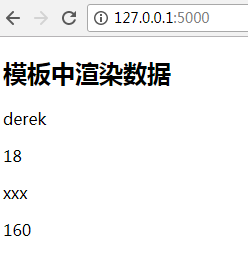2.Flask jinjia2模板
1.1.模板传参
(1)主程序
from flask import Flask,render_template app = Flask(__name__) @app.route('/') def hello_world(): context = { 'username':'derek', 'age':18, 'gf':{ 'name':'xxx', 'height':160 } } return render_template('index.html',**context) #加双下划綫,就可以直接获取key和value了 if __name__ == '__main__': app.run(debug=True)
(2)index.html
<h2>模板中渲染数据</h2>
<p>{{ username }}</p>
<p>{{ age }}</p>
<p>{{ gf.name }}</p>
<p>{{ gf['height'] }}</p>

1.2.过滤器
常用的过滤器
- abs:绝对值
- default:如果当前变量没有值,则会使用参数中的值来替代
- escape:转义字符
- first:返回一个序列的第一个元素
- format:格式化字符串
- last:返回一个序列的最后一个元素
- length:返回一个序列的长度
- join:拼接字符串
- safe:关掉转义
- int:转为int类型
- float:转为浮点类型
- lower:转换为小写
- upper:转换为答谢
- replace:替换
- truncate:截取length长度的字符串
- striptags:删除字符串中所有的html标签,如果出现多个空格,将替换成一个空格
default过滤器的使用
主程序
from flask import Flask,render_template app = Flask(__name__) @app.route('/') def hello_world(): context = { 'position':-9, 'signature':None #个性签名 } return render_template('index.html',**context) if __name__ == '__main__': app.run(debug=True)
index.html
<h2>过滤器</h2> <p>{{ position|abs }}</p> <p>个性签名:{{ signature|default('此人很懒,没有留下任何说明',boolean=True) }}</p>
也可以用or的方式
<h2>过滤器</h2> <p>{{ position|abs }}</p> {# <p>个性签名:{{ signature|default('此人很懒,没有留下任何说明',boolean=True) }}</p>#} <p>个性签名:{{ signature or '此人很懒,没有留下任何说明' }}</p>

1.3.自定义过滤器
过滤器本质上就是一个函数,如果在模板中调用这个过滤器,那么就会将这个变量的值作为第一个参数传给过滤器这个函数,
然后函数的返回值会作为这个过滤器的返回值。需要使用一个装饰器:@app.template_filter('args')
实例:自定义时间处理过滤器
主程序
from flask import Flask,render_template from datetime import datetime app = Flask(__name__) @app.route('/') def hello_world(): context = { 'create_time':datetime(2018,5,25,17,52,10) } return render_template('index.html',**context) @app.template_filter('handle_time') #括号里面是自己给过滤器起的名字 def handle_time(time): ''' 1.如果时间间隔小与1分钟以内,就显示“刚刚” 2.如果是1小时以内,显示“xx分钟” 3.如果24h以内,显示“xx小时前” 4.如果大于24小时小与30天,显示“xx天前” 5.大于一个月,显示具体的时间 :param time: :return: ''' if isinstance(time,datetime): now = datetime.now() timestamp = (now-time).total_seconds() #当前时间离创建时间的秒数 if timestamp < 60: #60s以内 return "刚刚" elif timestamp >= 60 and timestamp < 60*60: minutes = timestamp / 60 return "%s分钟前"%int(minutes) elif timestamp >= 60*60 and timestamp < 60*60*24: hours = timestamp / (60*60) return '%s小时前'%int(hours) elif timestamp >= 60*60*24 and timestamp < 60*60*24*30: days = timestamp / (60*60*24) return '%s天前'%int(days) else: return time.strftime('%Y/%m/%d %H:%M') else: return time if __name__ == '__main__': app.run(debug=True)
index.html
<h2>自定义时间过滤器</h2> {{ create_time|handle_time }}

1.4.if和for的使用
for中包含以下变量,可以用来获取当前的遍历状态
- loop.index
- loop.index0
- loop.first
- loop.last
- loop.length
if和for简单用法
from flask import Flask,render_template app = Flask(__name__) app.config.update({ 'DEBUG':True, 'TEMPLATES_AUTO_RELOAD':True }) @app.route('/') def hello_world(): context = { 'age':20, 'users':['tom','jack','alice'], 'person':{ 'name':'derek', 'age':18 } } return render_template('index.html',**context) if __name__ == '__main__': app.run(debug=True)
index.html
<!DOCTYPE html> <html lang="en"> <head> <meta charset="UTF-8"> <title>Title</title> </head> <body> {% if age >= 18 %} 欢迎 {% else %} 无权限 {% endif %} <ul> {% for user in users %} <li>{{ user }}</li> {% endfor %} </ul> <table> <thead> <tr> <th>用户名</th> <th>年龄</th> </tr> </thead> <tbody> <tr> {% for key,value in person.items() %} <td>{{ value }}</td> {% endfor %} </tr> </tbody> </table> </body> </html>

1.5.宏的使用和导入
模板的宏跟python中的函数类似,可以传递参数,但是不能有返回值,可以将一些经常用到的代码片段放到宏中,然后把一些
不固定的值抽取出来当成一个变量。
(1)简单使用实例
{# 定义一个宏,input是宏的名字,里面三个参数,可以指定默认参数值,也可以调用的传参#} {% macro input(name="",value="",type="text") %} <input name="{{ name }}" value="{{ value }}" type="{{ type }}"> {% endmacro %} <form> <p>用户名:{{ input('username') }}</p> <p>密码:{{ input('password',type="password" )}}</p> <p> {{ input(value="提交",type="submit" )}}</p> </form>

(2)宏的两种导入方式
新建macros.html
{% macro input(name="",value="",type="text") %} <input name="{{ name }}" value="{{ value }}" type="{{ type }}"> {% endmacro %}
index.html中导入使用宏
{#第一种#} {# with context可以把后端传到当前模板的变量传到定义的宏里面#} {% import "macros.html" as macro with context %} {#第二种#} {% from "macros.html" import input as input_field %} <!DOCTYPE html> <html lang="en"> <head> <meta charset="UTF-8"> <title>Title</title> </head> <body> {# 第一种#} <form> <p>用户名:{{ macro.input('username') }}</p> <p>密码:{{ macro.input('password',type="password" )}}</p> <p> {{ macro.input(value="提交",type="submit" )}}</p> </form> {# 第二种#} <form> <p>用户名:{{ input_field('username') }}</p> <p>密码:{{ input_field('password',type="password" )}}</p> <p> {{ input_field(value="提交",type="submit" )}}</p> </form> </body> </html>
1.6.set、with在模板中自定义变量
(1)set
在模板中可以使用set来定义变量,一旦定义了这个变量,在后面的代码中都可以使用,index.html
{% set usernmae='derek' %} <p>用户名:{{ usernmae }}</p>

(2)with
with语句定义的变量,只能在with语句代码块(endwith)里面使用,超过代码块,就不能再使用了,set语句没有end,全局使用
{% with age=18 %} <p>年龄:{{ age }}</p> {% endwith %}
1.7.蓝图的使用
目录如下:

(1)news.py
from flask import Blueprint
news_bp = Blueprint('new',__name__,url_prefix='/news')
@news_bp.route('/list/')
def news_list():
return '新闻列表'
(2)user.py
from flask import Blueprint
# 1.定义一个蓝图,'user':蓝图的名字,url_prefix='/user':给url加一个前缀,注意后面不要加'/'
user_bp = Blueprint('user',__name__,url_prefix='/user')
@user_bp.route('/profile/')
def profile():
return '个人中心'
(3)bluepoint_demo.py
from flask import Flask,url_for
# 2.导入
from blueprints.user import user_bp
from blueprints.news import news_bp
app = Flask(__name__)
# 3.注册蓝图
app.register_blueprint(user_bp)
app.register_blueprint(news_bp)
@app.route('/')
def hello_world():
return 'Hello World!'
with app.test_request_context():
print(url_for('new.news_list')) # /news/list/ 通过url_for反转url的时候要加蓝图的名字
print(url_for('user.profile')) # /user/profile/
if __name__ == '__main__':
app.run(debug=True)


posted on 2018-05-28 14:45 zhang_derek 阅读(3935) 评论(0) 编辑 收藏 举报



【推荐】国内首个AI IDE,深度理解中文开发场景,立即下载体验Trae
【推荐】编程新体验,更懂你的AI,立即体验豆包MarsCode编程助手
【推荐】抖音旗下AI助手豆包,你的智能百科全书,全免费不限次数
【推荐】轻量又高性能的 SSH 工具 IShell:AI 加持,快人一步
· .NET Core 中如何实现缓存的预热?
· 从 HTTP 原因短语缺失研究 HTTP/2 和 HTTP/3 的设计差异
· AI与.NET技术实操系列:向量存储与相似性搜索在 .NET 中的实现
· 基于Microsoft.Extensions.AI核心库实现RAG应用
· Linux系列:如何用heaptrack跟踪.NET程序的非托管内存泄露
· TypeScript + Deepseek 打造卜卦网站:技术与玄学的结合
· Manus的开源复刻OpenManus初探
· 三行代码完成国际化适配,妙~啊~
· .NET Core 中如何实现缓存的预热?
· 阿里巴巴 QwQ-32B真的超越了 DeepSeek R-1吗?